Paris Culture: The Pompidou Goes Pop!
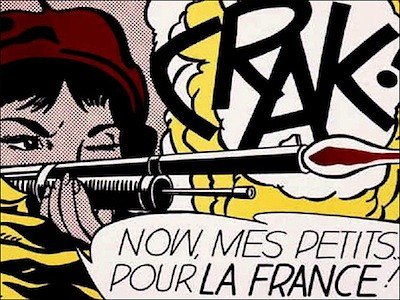
Mon 2 Sep 2013
With record-setting shows of Hopper, Dalí and haute couture, this year Paris culture has seen some blockbusters. Now, we have “Roy Lichtenstein”—the first retrospective of the pop star since he died in 1997. The ultimate American artist, New Yorker Lichtenstein was in love with his nation’s kitsch. In well over 100 works, its clichés are omnipresent here. But so are the painter’s strong ties to European art.
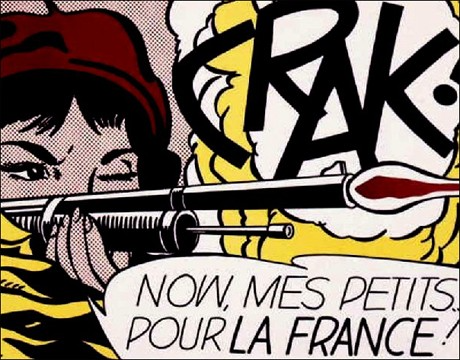
“Crak!,” Roy Lichtenstein, 1964. Photo: Centre Georges Pompidou.
This is the perfect show to see at the Centre Pompidou. Many of its themes and compositions are borrowed—from stars such as Picasso, Degas, Matisse, Monet and Manet. Starting with his famous ’60s pop cartoons, the painter’s work slowly progresses through a range of media. Just like his New York peers, Lichtenstein focuses on the means by which “modern life” is defined. He uses auto enamels to immortalize a sunrise and re-creates everyday crockery as ceramic sculptures. He even works in Perspex, plastics, gift wrap and textiles.
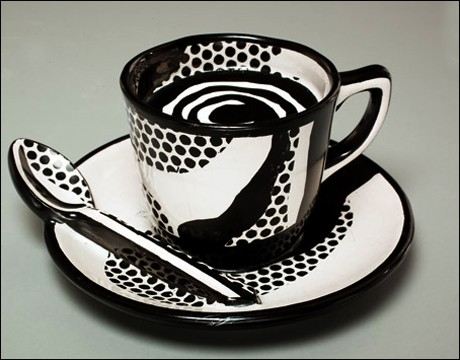
Ceramic sculpture, Roy Lichtenstein, 1965. Photo: Centre Georges Pompidou.
All of this artist’s pieces feature his trademark Benday dots—a trick Lichtenstein lifted from 19th-century printing. (The name pays homage to the method’s inventor, Benjamin Day.) To convey color and perspective through their spacing, these dots make use of an optical illusion. They also produce the sense Lichtenstein’s work has been “manufactured.” At first glance, the system looks simple yet the skill with which its dots are made and placed is meticulous. Ironically, Benday dots are hard to reproduce well—seeing the iconic pieces themselves will surprise you.
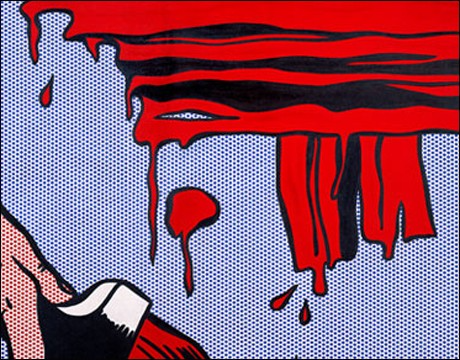
“Brushstrokes” (detail), Roy Lichtenstein, 1965. Photo: Centre Georges Pompidou.
Much of Lichtenstein’s later art quotes from European painting, making allusions to works such as Velázquez’s Las Meninas. There are replicas, too, such as the artist’s version of Van Gogh’s Bedroom in Arles. But, by design, none of the paintings hold subtleties. “It’s all supposed to look false,” Lichtenstein once said, “and it does.” He believed subtlety played no part in American life.
Lichtenstein was fascinated by the way that life comes filtered through advertising and iconography. So he tried to work in the way an illustrator draws, saying, “Illustrators don’t look at things, they learn to make symbols for them.” The painter went on to invent symbols of his own, many of which have become famous. The end result, in primary colors, is a show with amazing energy.
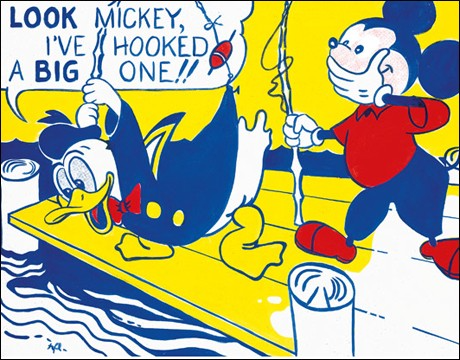
“Look Mickey,” Roy Lichtenstein, 1961. Photo: Centre Georges Pompidou.
In Paris culture, of course, cartoons and graphic novels matter. Comics (known here as les bandes dessinées or “BD”) are accepted both as art and literature. Growing up before World War II, Lichtenstein loved these; he was a huge fan of superheroes and serials. A second affiliation that brings him close to the French is jazz, about which the painter was passionate all his life. His stylish, precise art resonates with this sensibility.
But that’s not because Lichtenstein ever improvised. It’s a matter of sharp edges, finish and contained emotions. Although this artist is known for his irony, his works are filled with buoyancy and an easygoing humor.
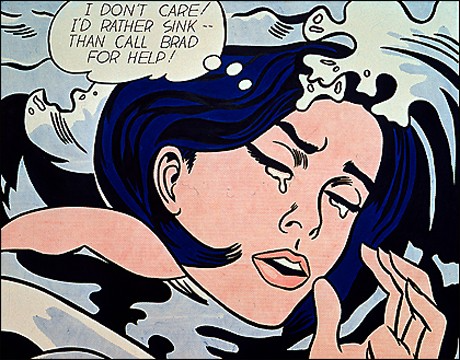
“Drowning Girl” or “I Don’t Care, I’d Rather Sink” (detail), Roy Lichtenstein, 1963. Photo: Centre Georges Pompidou.
It’s hard to argue the best paintings are not the earliest—the world-famous images of Whaam!, Drowning Girl and Masterpiece. But, if Lichtenstein’s later nude studies fail to convince, his mid-’90s take on Chinese landscape is fascinating. With long and vertical proportions like those of a scroll, these offer an eerie, mechanical Zen poetry. The combination of ’60s classics with such style is hard to resist.
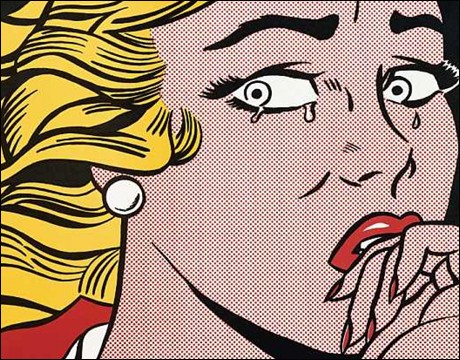
“Crying Girl” (detail), Roy Lichtenstein, 1963. Photo: Centre Georges Pompidou.
• With any such landmark in the Paris culture calendar, be sure you book ahead! Also bear in mind the crowds will make it hard to see. Your best bet is going very early or very late.
• The exhibition is on view until November 4.
Related Links
Roy Lichtenstein
Centre Pompidou
Editor’s note: Have you heard about the GG2P Travel Club yet? There are three levels at which to join—and the first one is free!